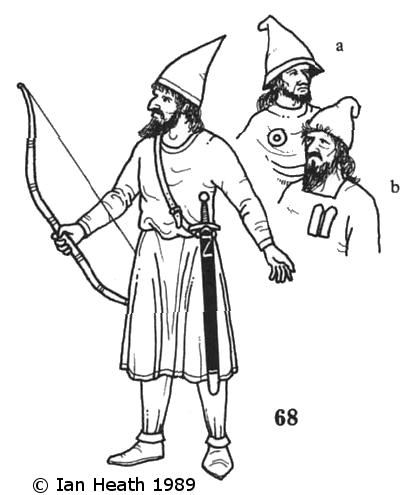Create an Amazon Business Account

Try Amazon Audible Premium Plus and Get Up to Two Free Audiobooks
JEWISH SOLDIER, 11th-13th CENTURIES
An extract from Armies of Feudal Europe 1066-1300
by Ian Heath

[Based on Siege of Jerusalem, in Las Huelgas Apocalypse by Beatus of Liébana]
[63b based on Rochester Chronicle (British Library, Cotton Nero D. II.), folio 183v]
68. JEWISH SOLDIER, 11th-13th CENTURIES
From his trucculent beard and characteristic pointed cap (of which details a and b show variants) it seems fairly certain that this figure, from a Spanish ms. various1y dated to the late-12th century and c. 1220, represents a Jewish soldier such as are occasionally recorded serving as infantrymen in Christian Spanish armies throughout this era. Later Moslem sources refer to 'large numbers' of Jews fighting for the Christians at major battles (Sagrajas, for example), though more often they only assisted in the defence of the towns in which they lived. Nevertheless, Jews resident on monastic land, or estates belonging to the Military Orders, often actually garrisoned frontier fortresses, receiving tax reductions in exchange for their military service. Probably the only reason that they did not feature more prominently in Christian armies was the mindless anti-Semitism that was apparent even n mediaeval limes - to quote but one example, Christian troops arriving to relieve Toledo in 1196 killed many of the towns Jewish defenders as infidels, despite the fact that the latter had marched our and fought against the Almohades during the siege. Even so, there are occasional references to Jewish soldiers even in the 13th-14th centuries. A document of 1266 refers to Jewish ballesteros (ie, archers) amongst the holders of property in Jerez de la Frontera, while Jews are recorded being killed fighting for Castile in 1272 and defending Gerona against the French in 1285. Nearly a century later, at the Battle of Montiel in 1369, King Pedro the Cruel of Castile's army is reported by Froissart to have contained 'fierce and strong people such as Saracens, Jews and Portuguese', though with predictable bigotry he claims that 'the Jews turned their backs and fled and fought no stroke'.
The original ms. contains two such figures as are depicted here. One wears a rust-coloured tunic and brown leggings, the other a green tunic and red leggings. The hat and baldric are red in both cases and the shoes are black. 68a depicts the badge, a circle about 2" across, that the Third (1179) and Fourth (1215) Lateran councils had decreed that all Jews should be obliged to wear so as to distinguish them from Christians. (Figure 68b wears an alternative badge that English Jews were ordered to wear in 1275, comprising two 'strips of yellow cloth, 6" long and 3" wide'.)
Jews were expected to perform military service in some parts of Europe other than Spain but chiefly in an unarmed capacity (a l3th century German ms., for instance, contains a representational picture of a body of militia, amongst whom is an unarmed Jew).
Next: 69. ARAGONESE JINETE, 13th CENTURY in Armies of Feudal Europe 1066-1300 by Ian Heath


